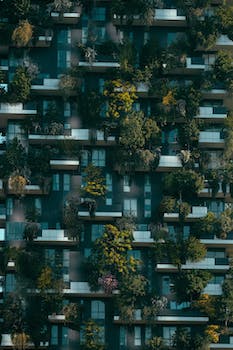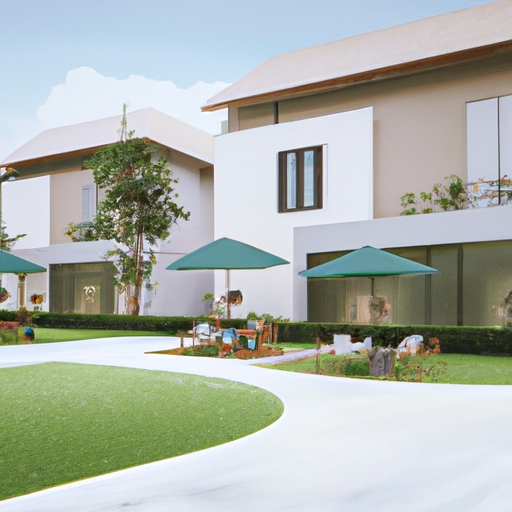Top Architectural Features for a Modern Retirement Complex
Designing a modern complex that’s perfect for your retirement years requires careful consideration of various architectural features that cater to the unique needs and preferences of retirees. As the population ages, there is an increasing demand for retirement complexes that offer not only comfortable living spaces but also a range of amenities and services that promote an active, healthy, and social lifestyle. In this article, we will discuss some of the top architectural features that should be incorporated into a modern retirement complex to ensure it meets the needs of its residents.
One of the most important aspects of a retirement complex is its accessibility. As people age, they may experience mobility issues or require the use of assistive devices such as wheelchairs or walkers. Therefore, it is essential to design a complex with wide, well-lit corridors, ramps, and elevators to accommodate these needs. Additionally, doorways should be wide enough to allow for easy passage, and handrails should be installed in hallways and stairwells to provide support.
Another key feature of a modern retirement complex is the incorporation of energy-efficient and sustainable design elements. This not only helps to reduce the environmental impact of the complex but also contributes to lower utility costs for residents. Some examples of sustainable design features include solar panels, energy-efficient windows, and well-insulated walls. Additionally, incorporating natural lighting and ventilation into the design can help to create a more comfortable living environment while reducing energy consumption.
The layout of a retirement complex should also promote social interaction and a sense of community among residents. This can be achieved by including communal spaces such as lounges, dining areas, and outdoor spaces where residents can gather and socialize. These spaces should be designed with comfort and accessibility in mind, with ample seating and tables that can accommodate wheelchairs and walkers. Additionally, the inclusion of recreational facilities such as fitness centers, swimming pools, and hobby rooms can encourage residents to stay active and engaged in their community.
Safety and security are also crucial considerations when designing a modern retirement complex. This can be achieved through the use of security cameras, well-lit outdoor areas, and secure entry systems. Additionally, incorporating emergency call systems in each living unit can provide residents with peace of mind, knowing that help is just a button press away should they require assistance.
Another important aspect of a retirement complex is the availability of on-site healthcare services. This can range from having a nurse or doctor on call to providing a fully-staffed medical facility within the complex. Providing easy access to healthcare services not only offers convenience for residents but can also contribute to their overall well-being and peace of mind.
Lastly, the aesthetic appeal of a retirement complex should not be overlooked. A well-designed complex with attractive landscaping and modern architectural features can create a welcoming and pleasant environment for residents. Additionally, incorporating elements of universal design, such as contrasting colors and textures, can help to make the complex more visually appealing and easier to navigate for residents with visual impairments.
In conclusion, designing a modern retirement complex that meets the needs of its residents requires careful consideration of various architectural features. By incorporating elements of accessibility, sustainability, social interaction, safety, healthcare, and aesthetics, a retirement complex can provide a comfortable and enjoyable living environment for retirees. As the demand for retirement complexes continues to grow, it is essential for architects and developers to prioritize these features in their designs to ensure the success and satisfaction of their residents.
Integrating Wellness and Leisure Amenities in Your Retirement Complex Design

Designing a modern complex that caters to the needs and desires of retirees requires a thoughtful approach to integrating wellness and leisure amenities. As the baby boomer generation continues to age, the demand for retirement communities that offer a wide range of services and activities is on the rise. In order to create a space that is perfect for your retirement years, it is essential to consider the various aspects of wellness and leisure that can be incorporated into the design of your complex.
One of the most important aspects of wellness in a retirement complex is the availability of fitness facilities and programs. Regular exercise is crucial for maintaining physical health and mobility, as well as promoting mental well-being. A modern retirement complex should include a well-equipped gym, with a variety of exercise machines and equipment to cater to different fitness levels and preferences. Additionally, offering group fitness classes, such as yoga, Pilates, or water aerobics, can provide a social aspect to exercise and encourage residents to stay active and engaged.
Another key component of wellness is access to healthcare services. A retirement complex should be designed with the needs of its residents in mind, which may include on-site medical facilities or easy access to nearby hospitals and clinics. Providing residents with the peace of mind that their healthcare needs can be met within the community can greatly contribute to their overall well-being.
Nutrition is also an essential aspect of wellness, and a retirement complex should offer dining options that cater to a variety of dietary needs and preferences. This may include an on-site restaurant or café that offers healthy meal options, as well as communal kitchens where residents can prepare their own meals. Additionally, providing access to fresh produce through a community garden or local farmers’ market can encourage residents to maintain a healthy diet and foster a sense of community.
In addition to wellness amenities, leisure activities play a significant role in creating a fulfilling retirement experience. A modern retirement complex should offer a variety of recreational facilities and programs that cater to the diverse interests of its residents. This may include a swimming pool, tennis courts, or a golf course, as well as spaces for hobbies such as woodworking, painting, or gardening.
Social interaction is another crucial aspect of leisure in a retirement community. Designing communal spaces, such as lounges, libraries, or game rooms, can encourage residents to interact with one another and form lasting friendships. Additionally, offering organized social events, such as movie nights, book clubs, or holiday celebrations, can help to create a sense of community and belonging among residents.
Finally, it is important to consider the location of your retirement complex in relation to local attractions and amenities. Proximity to shopping centers, restaurants, and cultural attractions can provide residents with a variety of leisure options and help to maintain their independence. Additionally, easy access to public transportation or shuttle services can enable residents to explore their surroundings and stay connected to the larger community.
In conclusion, designing a modern retirement complex that is perfect for your golden years requires a thoughtful approach to integrating wellness and leisure amenities. By considering the various aspects of physical and mental well-being, as well as providing opportunities for social interaction and recreation, you can create a space that promotes a healthy, active, and fulfilling retirement experience. With careful planning and attention to detail, your retirement complex can become a haven for residents to enjoy their well-deserved leisure years.
Sustainable and Eco-Friendly Practices for Designing a Retirement Complex
Designing a modern complex that is perfect for your retirement years requires careful consideration of various factors, including sustainability and eco-friendliness. As the world becomes more environmentally conscious, it is essential to incorporate sustainable practices into the design of retirement complexes to ensure that they are not only comfortable and functional but also have a minimal impact on the environment. This article will discuss some of the sustainable and eco-friendly practices that can be employed when designing a retirement complex.
One of the most critical aspects of sustainable design is energy efficiency. A retirement complex should be designed to minimize energy consumption and maximize the use of renewable energy sources. This can be achieved through various means, such as incorporating solar panels, wind turbines, and geothermal systems into the design. Additionally, the complex should be well-insulated to reduce heat loss and energy consumption for heating and cooling. High-performance windows, energy-efficient lighting, and smart thermostats can also contribute to reducing the overall energy consumption of the complex.
Another essential aspect of sustainable design is water conservation. A retirement complex should be designed to minimize water usage and promote water recycling. This can be achieved by installing low-flow fixtures, such as faucets, showerheads, and toilets, which use less water than traditional fixtures. Rainwater harvesting systems can also be incorporated into the design to collect and store rainwater for use in irrigation and other non-potable applications. Additionally, greywater recycling systems can be used to treat and reuse water from sinks, showers, and laundry for irrigation and toilet flushing, further reducing the complex’s overall water consumption.
The choice of building materials also plays a significant role in the sustainability of a retirement complex. Sustainable building materials are those that have a minimal impact on the environment, both during their production and throughout their lifecycle. Examples of sustainable building materials include recycled steel, reclaimed wood, and rammed earth. These materials not only have a lower environmental impact but can also contribute to improved indoor air quality and overall occupant health. Additionally, using locally sourced materials can help reduce the carbon footprint associated with transportation and support local economies.
Landscaping is another area where sustainable practices can be employed in the design of a retirement complex. Native plants should be used in landscaping, as they require less water and maintenance than non-native species and provide habitat for local wildlife. Incorporating green spaces, such as gardens and parks, can also contribute to the overall well-being of residents by providing opportunities for outdoor recreation and social interaction. Furthermore, permeable paving materials can be used in parking lots and walkways to reduce stormwater runoff and promote groundwater recharge.
Lastly, waste management is an essential aspect of sustainable design. A retirement complex should be designed to facilitate waste reduction, recycling, and composting. This can be achieved by providing easily accessible recycling and composting facilities for residents and implementing waste reduction strategies, such as using durable, reusable materials in construction and furnishing.
In conclusion, incorporating sustainable and eco-friendly practices into the design of a retirement complex can significantly reduce its environmental impact while providing a comfortable, healthy, and enjoyable living environment for residents. By focusing on energy efficiency, water conservation, sustainable building materials, eco-friendly landscaping, and waste management, designers can create a modern complex that is perfect for retirement years and contributes to the overall well-being of both residents and the planet.
Q&A
Question 1: What are the key features to consider when designing a modern complex for retirement years?
Answer 1: The key features to consider when designing a modern complex for retirement years include accessibility, safety, low-maintenance design, social and recreational amenities, and healthcare facilities nearby.
Question 2: How can technology be integrated into the design of a retirement complex to enhance the quality of life for residents?
Answer 2: Technology can be integrated into the design of a retirement complex by incorporating smart home systems for climate control, security, and lighting; providing high-speed internet access; installing emergency call systems; and offering telemedicine services for remote healthcare consultations.
Question 3: What are some sustainable design elements that can be incorporated into a retirement complex to promote environmental responsibility?
Answer 3: Sustainable design elements that can be incorporated into a retirement complex include energy-efficient building materials, solar panels for renewable energy generation, rainwater harvesting systems, green roofs and gardens, and efficient waste management and recycling programs.
Conclusion
In conclusion, designing a modern complex for retirement years involves careful consideration of factors such as accessibility, safety, comfort, and social engagement. By incorporating age-friendly features, sustainable design elements, and opportunities for community interaction, a well-planned retirement complex can significantly enhance the quality of life for its residents, ensuring a fulfilling and enjoyable retirement experience.


